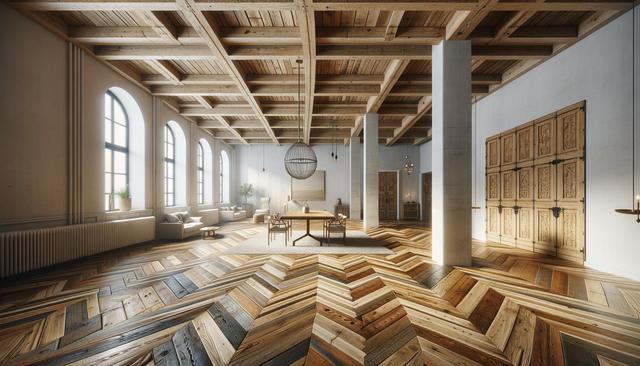
Timeless Charm: Exploring the Beauty and Benefits of Reclaimed Wood Floors
What Are Reclaimed Wood Floors?
Reclaimed wood floors are made from wood salvaged from old buildings, barns, factories, and warehouses. This wood is often decades or even centuries old, offering a distinct patina and character that new wood simply can’t replicate. Each plank carries a story, showcasing marks from saw blades, nail holes, and natural aging processes. Popular examples include reclaimed chestnut wood and old pine wood flooring, both known for their rich textures and warm tones. This type of flooring is not just about aesthetics — it’s also an environmentally conscious choice, reducing the need for new lumber and minimizing waste.
Because reclaimed wood is repurposed from older structures, it’s typically denser and more durable than freshly milled wood. These qualities make it a practical choice for high-traffic areas in both homes and commercial spaces. Whether you’re aiming for a rustic farmhouse vibe or an industrial-modern look, reclaimed wood floors adapt well to various design styles.
Types of Reclaimed Wood Flooring
There are several types of reclaimed wood used in flooring, each offering unique characteristics and visual appeal. Among the most popular options are:
- Reclaimed chestnut wood: Known for its rarity and distinctive grain patterns.
- Old pine wood flooring: Offers a soft, warm appearance with visible knots and age marks.
- Refurbished parquet flooring: Adds sophistication with its classic geometric patterns.
In addition to solid hardwood varieties, engineered wide plank reclaimed wood flooring has become increasingly popular. This type of flooring consists of a top layer of reclaimed wood bonded to multiple layers of plywood, enhancing its stability and making it suitable for installation over radiant heat systems or concrete subfloors. Engineered options are particularly useful in environments where moisture levels fluctuate, such as basements or kitchens.
The Environmental Appeal of Refurbished Flooring
One of the most compelling reasons to choose reclaimed wood floors is their environmental benefit. By repurposing existing wood, homeowners and designers help conserve natural resources and reduce the demand for logging. This practice supports forest preservation and lowers the overall carbon footprint associated with producing new materials.
Additionally, using refurbished flooring helps divert materials from landfills. Many reclaimed wood planks originate from buildings that would otherwise be demolished and discarded. Instead of contributing to waste, these materials are given a new purpose, enriching modern interiors with history and character. Choosing reclaimed options also encourages a circular economy, where materials are reused and recycled rather than disposed of.
Installation and Maintenance Considerations
Installing reclaimed wood floors requires careful preparation and attention to detail. Since the wood has already lived a full life, it often needs to be cleaned, kiln-dried, and milled to standard sizes before installation. Working with experienced professionals ensures the wood is properly acclimated to its new environment and laid in a way that maximizes longevity and aesthetic appeal.
Maintenance of reclaimed flooring is relatively straightforward. Regular sweeping or vacuuming, occasional damp mopping, and using protective pads under furniture help preserve the wood’s finish. Over time, minor scratches and scuffs add to the charm rather than detract from it, enhancing the lived-in feel that many homeowners desire. Applying a new finish every few years can refresh the look while maintaining the wood’s protective layer.
Design Versatility and Style Options
Reclaimed wood floors offer exceptional design versatility. Their varied tones and textures can complement both traditional and contemporary spaces. Whether paired with sleek modern furnishings or vintage décor, reclaimed flooring adds warmth and authenticity to any setting. Engineered wide plank reclaimed wood flooring, in particular, provides a modern twist with its broad surface area and uniform installation.
Designers and homeowners often use refurbished parquet flooring in formal spaces such as dining rooms and entryways, where the intricate patterns can act as a focal point. Meanwhile, old pine wood flooring remains a favorite for cozy bedrooms and rustic kitchens. The beauty of reclaimed wood lies in its imperfections — knots, grain variations, and subtle color changes contribute to a one-of-a-kind floor that can’t be duplicated.

